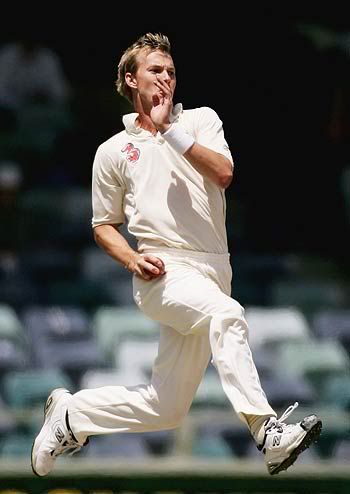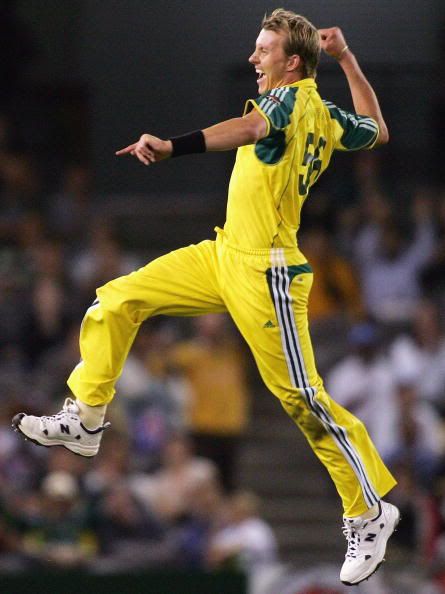
Brett Lee (born 8 November 1976 in Wollongong, New South Wales) is an Australian cricketer.
After breaking into the Australian Test team, Lee was recognised as one of the fastest bowlers in world cricket. He is also an athletic fielder and useful lower-order batsman, with a batting average exceeding 20.
Style:
Lee is an express bowler, one of the fastest the game has known, and is capable of bowling at 160 km/h (99 mph). Lee's fastest recorded delivery to date is 160.8 km/h (99.9 mph) which he bowled in his first over on March 5, 2005 at Napier, New Zealand against Craig Cumming. He is also an athletic fielder and aggressive lower-order batsman with a batting average exceeding 20.
Lee ranks with Pakistani bowler Shoaib Akhtar as the fastest bowler in contemporary cricket. Akhtar's delivery at 161.4km/h (100.2mph) stands as the fastest recorded to date.
Lee's speed allows opposition batsmen less time to react, increasing their chances of making a mistake and has bowled with great accuracy as Australia's bowling spearhead. He has a Test bowling average of just under thirty, which sees him ranked in the 5th in the International Cricket Council's Test bowling rankings.
Early in his career, Lee was reported for a suspected illegal bowling action, but was cleared. He was also criticised in early 2005 for bowling a series of beamers at batsmen during ODIs, at a rate which lead some to claim he was deliberately bowling illegal head high full tosses at batsmen.
Lee is at his most effective on the pitches of the southern hemisphere, where the pitches have greater bounce. In the northern hemisphere, he has taken 53 wickets in 19 Tests at an average of 42.11. In the southern hemisphere, he has taken 178 wickets in 40 matches at 28.48. He has had the most success against the West Indies and New Zealand, averaging in the low twenties. He averages more than 40 against England, Bangladesh and Pakistan, and in the 30s against other teams.
He played his first formal game of cricket for the Oak Flats Rats where he took 6/0 from one over or 6 wickets for 0 runs, all of his wickets being bowled [citation needed]. At sixteen years of age, Lee began playing first grade cricket for Campbelltown, where he managed to claim the wickets of a few New South Wales cricketers. He later joined Mosman, where at one point, he shared the new ball with Shoaib Akhtar.
Lee also played for the Australian Under 17 & 19 teams and was awarded a scholarship to attend the Australian Cricket Academy.
In March 1994, Lee was forced out of the Australian under-19 team to tour India due to stress fractures in his lower back. He recovered and made his first-class debut for New South Wales against Western Australia in a Sheffield Shield match as a 20-year old in the 1997–98 season, playing one match and taking 3/114.
One month later, Lee was chosen to represent the Australian A team on a tour to South Africa. He claimed two wickets but in that very match, stress fractures in his back from the previous injury had re-opened and Lee was in a back brace for over three months. When he turned twenty-one, Lee moved to Sydney to be closer to work.
During the 1997-98 season, he played in five of the ten Sheffield Shield games, taking fourteen wickets at 30. He finished outside the top 20 in both the wicket taking list and the bowling averages. In 1999, during a Sheffield Shield match at Perth, Lee bowled a spell against the Western Australian batsmen, compared the fastest bowling seen in Australia since the days of Jeff Thomson back in the 1970s. From that point, Australian captain Steve Waugh and then vice-captain Shane Warne began pushing for Lee's inclusion in the Test team.
Early Test career:
By the late 1990s there were calls for Lee to be included in the national squad. He was eventually chosen in the final 14 for the Test series against Pakistan in 1999 but failed to make the final 11. By the time the Test series against India came around, he was twelfth man. However, he duly made his Test debut for Australia in December 1999 against the touring Indians, becoming Australia's 383rd Test cricketer.
Bowling first change, Lee took a wicket in his first over in Test cricket when he bowled Sadagoppan Ramesh with his fourth delivery. He also captured Rahul Dravid in his first spell before returning to take three wickets in six balls to finish the innings with figures of 5/47 from 17 overs. Australia had batted first, and Lee had earlier made 27 runs. Lee took thirteen wickets in his opening two Tests at the low average of 14.15.
Lee won the inaugural Donald Bradman Young Player of the Year Award at the Allan Border Medal award ceremony in 2000 soon after his debut.
During the early 2000 tour to New Zealand, Lee was reported by umpires Srinivas Venkataraghavan and Arani Jayaprakash for a suspected illegal bowling action. He was later cleared.
Lee took 42 wickets in his opening three series, the most by any Australian bowler in the seven matches he played. However, in his seventh Test, where he took seven wickets including a five wicket haul in the second innings against the West Indies, he suffered a stress fracture of the lower back which kept him out of three following Tests. He returned against Zimbabwe but soon suffered another setback a month later when he broke his right elbow and was sidelined until May 2001.
Spearhead of the bowling attack:
Many wondered how Lee would manage the role as the permanent leader of the pace attack upon the retirements of cricket greats Glenn McGrath and Shane Warne. However despite scepticism he has already shown sensational form in the role being awarded the Man of the Series in the inaugural Warne-Muralitharan Trophy against Sri Lanka in late 2007. In his first series as bowling figure-head he reaped a phenomenal 16 wickets in two tests at an average of 17.5 stamping himself as the man for the job. This has been achieved by bowling 5 km/h slower to improve accuracy. In the two-test series he also took out each Man of the Match awards. In the following series Lee continued his blistering form taking 24 wickets at 22.58 in four tests against India. In the test series he also overtook Jason Gillespie to become Australia's 5th highest wicket taker. His consistent efforts saw him rewarded with the Man of the Series Award for the Border-Gavaskar Trophy, 2007/08. He capped off the season by winning the Allan Border Medal, the award given to Australia's best cricketer of the season.
Lee seemed underdone in the 2008 Australian tour of the West Indies, taking only 5 wickets in the first test match, during which he seemed exhausted. But he got back into the swing of things taking 8 wickets in the second test, including a 5 wicket haul, and 6 in the next test. Overall he seemed to regain his form as the series went on but was often tired by the extra workload; Mitchell Johnson did not live up to expectations until the final test, Stuart MaGill (who retired at the conclusion of the second test) also under-performed with the ball, and Symonds picked up a back injury which meant he could not bowl as often as anticipated.
One-day International career:
Lee made his debut in One Day International for Australia against Pakistan on 9 January 2000 during the Carlton and United Breweries Series at the Gabba, Brisbane. He became the 140th ODI cricketer to represent Australia.
In One-day Internationals Lee is widely regarded as one of the world's finest and most feared bowlers, he was ranked by the ICC as the No. 1 ODI bowler in January 2006 and has been ranked among the top ten ODI bowlers since the start of 2003. He has a wide array of deliveries including a dangerous in-swinging yorker. His bowling strike rate of around 30 puts him amongst the most incisive in this form of the game. He also has a One-day International hat-trick to his name, achieved in the 2003 World Cup against Kenya. Lee was the first Australian and fourth bowler to ever achieve this feat in World Cup history.
In the matches Australia played in the 2005-06 triangular one day series, Lee gave a display of his useful batting abilities by making 57 in the second game in a 100 run partnership with Michael Hussey to pull Australia out of a middle order collapse. However, he is yet to consistently contribute with his batting, and his current ICC ranking hovers around the 90-100 region.
Lee finished the series with 15 wickets, the third highest tally behind Nathan Bracken and Muttiah Muralitharan.
While Lee's average and strike rate in ODIs rank him as one of the best strike bowlers in ODI history, he can still be erratic occasionally, as shown by his relatively high economy rate.
Lee also has the ability to take wickets very early in the innings, often removing batsmen in the first over of the innings. The delivery he bowled to Marvan Atapattu in the semi-final of the 2003 Cricket World Cup, reached 160.1 km/h (99.5 mph).
Batting:
Lee's batting has always shown potential and in recent times has been improving, averaging just over twenty in both forms of international cricket in the last two years. He has said that he would like to become an all rounder though it is not a main priority. During the 2005 Ashes series, Lee had numerous defiant innings, and showed promise as a batsman. Lee's aggressive style and strong physique often yields many sixes, including one six which flew out of the Gabba (Brisbane) during a Test match against the West Indies in 2005, billed as the biggest six ever hit at that ground.
On 2 April 2006, Lee hit his highest Test score of 64 in 68 balls against South Africa at Johannesburg. His previous highest score in Tests was 62 not out which he made against the West Indies in 2000 at the Gabba. Lee nearly surpassed this score on 3 January 2008 against India when he made 59 off 121 balls. Lee had also once again nearly surpassed his highest test score when he had made 63 not out, but unfortunately Ricky Ponting had declared the innings in the 2nd test against the West Indies. As a result of this, he fell one run short of his highest test score.
Lee's highest score in ODI matches is 57 against South Africa at the Gabba in January 2006 with his previous best being 51 against South Africa in 2002.
Awards:
Career highlights:
Tests:
One-day Internationals:
ODI Debut: vs Pakistan, Gabba, Brisbane, 1999-2000
Other highlights:
Personal:
Lee married Elizabeth Kemp in June 2006. They have a son named Preston Charles, born 16 November 2006. However, after two years of marriage, on 21 August 2008 Lee confirmed his separation from Kemp.
Lee is part of the rock band Six & Out. The band is made up of his brother Shane and former New South Wales cricketers Brad McNamara, Gavin Robertson and Richard Chee Quee. Lee plays the bass guitar or acoustic guitar for the band.
During the 2006 ICC Champions Trophy in India, Lee recorded a duet with India's music diva Asha Bhosle called You're the One For Me. The song reached a peak position of number two on the Indian and South African charts. In 2008, he filmed scenes for his first Bollywood movie Victory.
Lee launched his own fashion label 'BL', in 2001.
Lee will be performing the theme song for the 2011 Cricket World Cup, which will be hosted by India, Pakistan, Sri Lanka, and Bangladesh.
Links to more information about Brett Lee:
*Acknowledgements to Wikipedia.org and owners of pictures and videos used.
















No comments:
Post a Comment